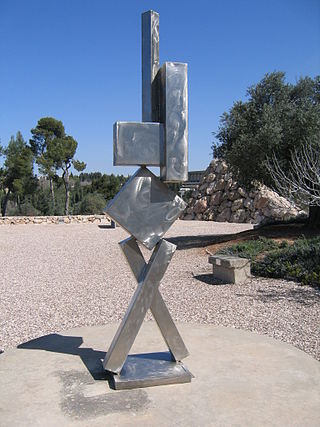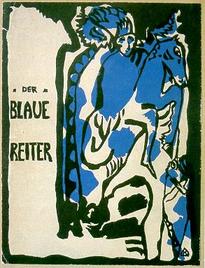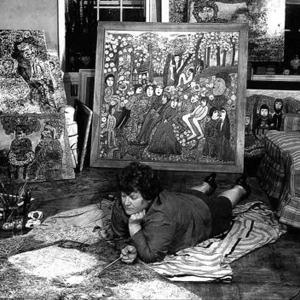Related Research Articles

Wassily Wassilyevich Kandinsky was a Russian painter and art theorist. Kandinsky is generally credited as one of the pioneers of abstraction in western art. Born in Moscow, he spent his childhood in Odessa, where he graduated from Odessa Art School. He enrolled at the University of Moscow, studying law and economics. Successful in his profession, he was offered a professorship at the University of Dorpat. Kandinsky began painting studies at the age of 30.

Expressionism is a modernist movement, initially in poetry and painting, originating in Northern Europe around the beginning of the 20th century. Its typical trait is to present the world solely from a subjective perspective, distorting it radically for emotional effect in order to evoke moods or ideas. Expressionist artists have sought to express the meaning of emotional experience rather than physical reality.

Abstract expressionism in the United States emerged as a distinct art movement in the immediate aftermath of World War II and gained mainstream acceptance in the 1950s, a shift from the American social realism of the 1930s influenced by the Great Depression and Mexican muralists. The term was first applied to American art in 1946 by the art critic Robert Coates. Key figures in the New York School, which was the epicenter of this movement, included such artists as Arshile Gorky, Jackson Pollock, Franz Kline, Mark Rothko, Norman Lewis, Willem de Kooning, Adolph Gottlieb, Clyfford Still, Robert Motherwell and Theodoros Stamos among others.

Abstract art uses visual language of shape, form, color and line to create a composition which may exist with a degree of independence from visual references in the world.

Hard-edge painting is painting in which abrupt transitions are found between color areas. Color areas often consist of one unvarying color. The Hard-edge painting style is related to Geometric abstraction, Op Art, Post-painterly Abstraction, and Color Field painting.

Der Blaue Reiter was a group of artists and a designation by Wassily Kandinsky and Franz Marc for their exhibition and publication activities, in which both artists acted as sole editors in the almanac of the same name, first published in mid-May 1912. The editorial team organized two exhibitions in Munich in 1911 and 1912 to demonstrate their art-theoretical ideas based on the works of art exhibited. Traveling exhibitions in German and other European cities followed. The Blue Rider disbanded at the start of World War I in 1914.

Gabriele Münter was a German expressionist painter who was at the forefront of the Munich avant-garde in the early 20th century. She studied and lived with the painter Wassily Kandinsky and was a founding member of the expressionist group Der Blaue Reiter.

Hans Hofmann was a German-born American painter, renowned as both an artist and teacher. His career spanned two generations and two continents, and is considered to have both preceded and influenced Abstract Expressionism. Born and educated near Munich, he was active in the early twentieth-century European avant-garde and brought a deep understanding and synthesis of Symbolism, Neo-impressionism, Fauvism, and Cubism when he emigrated to the United States in 1932. Hofmann's painting is characterized by its rigorous concern with pictorial structure and unity, spatial illusionism, and use of bold color for expressive means. The influential critic Clement Greenberg considered Hofmann's first New York solo show at Peggy Guggenheim’s Art of This Century in 1944 as a breakthrough in painterly versus geometric abstraction that heralded abstract expressionism. In the decade that followed, Hofmann's recognition grew through numerous exhibitions, notably at the Kootz Gallery, culminating in major retrospectives at the Whitney Museum of American Art (1957) and Museum of Modern Art (1963), which traveled to venues throughout the United States, South America, and Europe. His works are in the permanent collections of major museums around the world, including the Metropolitan Museum of Art, Tate Modern, Germanisches Nationalmuseum, National Gallery of Art, and Art Institute of Chicago.

Hildegard Anna Augusta Elisabeth FreiinRebay von Ehrenwiesen, known as Baroness Hilla von Rebay or simply Hilla Rebay, was an abstract artist in the early 20th century and co-founder and first director of the Solomon R. Guggenheim Museum. She was a key figure in advising Solomon R. Guggenheim to collect abstract art, a collection that would later form the basis of the Solomon R. Guggenheim Museum collection. She was also influential in selecting Frank Lloyd Wright to design the current Guggenheim museum, which is now known as a modernist icon in New York City.
Twentieth-century art—and what it became as modern art—began with modernism in the late nineteenth century.

Barbara Ellen Rose was an American art historian, art critic, curator and college professor. Rose's criticism focused on 20th-century American art, particularly minimalism and abstract expressionism, as well as Spanish art. "ABC Art", her influential 1965 essay, defined and outlined the historical basis of minimalist art. She also wrote a widely used textbook, American Art Since 1900: A Critical History.

Pan (1895–1915) was a Berlin-based German arts magazine, published by the PAN co-operative of artists, poets and critics. Focused on literature, theatre and music, the magazine published more than 20 issues "without reference to commercial, moral, personal or polemical questions, appreciating only the purely aesthetic viewpoint.” The magazine's mission was democratic in its commitment to Gesamtkunstwerk, and providing support to young artists of all kinds. To that end, the magazine sold tiered subscriptions: standard and luxury, and quickly "became the most expensive German art magazine of its era. Its artists-first commitment also led to its becoming one of the best representations of pan-European art in the early days of Abstract and Expressionist art.

20th-century Western painting begins with the heritage of late-19th-century painters Vincent van Gogh, Paul Cézanne, Paul Gauguin, Georges Seurat, Henri de Toulouse-Lautrec, and others who were essential for the development of modern art. At the beginning of the 20th century, Henri Matisse and several other young artists including the pre-cubist Georges Braque, André Derain, Raoul Dufy and Maurice de Vlaminck, revolutionized the Paris art world with "wild", multi-colored, expressive landscapes and figure paintings that the critics called Fauvism. Matisse's second version of The Dance signified a key point in his career and in the development of modern painting. It reflected Matisse's incipient fascination with primitive art: the intense warm color of the figures against the cool blue-green background and the rhythmical succession of the dancing nudes convey the feelings of emotional liberation and hedonism.

Janet Sobel, born Jennie Olechovsky, was a Ukrainian-born American Abstract Expressionist painter whose career started mid-life, at age forty-five in 1938. Sobel pioneered the drip painting technique that directly influenced Jackson Pollock. She was credited as exhibiting the first instance of all-over painting seen by Clement Greenberg, a notable art critic.
Rosemarie Haag Bletter is a German-born American architectural historian, university professor, writer, and lecturer.
John Millard Ferren was an American artist and educator. He was active from 1920 until 1970 in San Francisco, Paris and New York City.

Modern Theosophy has had considerable influence on the work of visual artists, particularly painters. Artists such as Wassily Kandinsky, Piet Mondrian, and Luigi Russolo chose Theosophy as the main ideological and philosophical basis of their work.

Landscape with Red Spots was the name given to each of two successive oil paintings produced in Bavaria in 1913 by the Russian émigré painter Wassily Kandinsky. The first is now in the Museum Folkwang, in Essen, Germany. The second, known as Landscape with Red Spots, No 2, is in the Peggy Guggenheim Collection, in Venice.
Isabel Wünsche is a German art historian and Professor of Art and Art History at Jacobs University Bremen.
References
- 1 2 3 4 5 "ROSE-CAROL WASHTON LONG". CUNY Graduate Center. Retrieved March 18, 2024.
- 1 2 3 4 5 6 7 8 Reports of the President and the Treasurer. John Simon Guggenheim Memorial Foundation. 1981. p. 75.
- ↑ "WASHTON. ABRAM A. "TED" WASHTON". Hartford Courant. December 26, 1994. Retrieved March 18, 2024.
- ↑ "Alice Washton Obituary (2005) - New London, CT, CT - The Day". Legacy.com. Retrieved March 18, 2024.
- ↑ "History-Making Class of 401 Graduated Before 1,700 at New London High School". The Day. June 9, 1955. p. 11. Retrieved March 18, 2024– via Newspapers.com.
- ↑ Washton, Rose-Carol (1968). VASILY KANDINSKY, 1909-1913: PAINTING AND THEORY (PhD thesis). Yale University. Retrieved March 18, 2024.
- 1 2 3 4 "Our People". The New Shul. Retrieved March 18, 2024.
- ↑ "CAA News" (PDF). CAA News. Vol. 22, no. 5. 1997. Retrieved March 18, 2024.
- ↑ "Rose-Carol Washton Long". John Simon Guggenheim Memorial Foundation. Retrieved March 18, 2024.
- ↑ "German Expressionism by Rose-Carol Washton Long - Paperback". University of California Press. Retrieved March 18, 2024.
- ↑ "Miss Washton Wed In Ceremony at Home". The Day. April 2, 1970. p. 13. Retrieved March 18, 2024– via Newspapers.com.
- ↑ Bowlt, John E. (1982). "Review of Kandinsky: The Development of an Abstract Style". The Russian Review. 41 (1): 111–112. doi:10.2307/129596. ISSN 0036-0341 – via JSTOR.
- ↑ Bowlt, John E. (1982). "Review of Kandinsky: The Development of an Abstract Style". Slavic Review. 41 (1): 191–192. doi:10.2307/2496702. ISSN 0037-6779 – via JSTOR.
- ↑ Clarke, Michael (1982). "Review of Kandinsky: The Development of an Abstract Style". The Slavonic and East European Review. 60 (1): 107–108. ISSN 0037-6795 – via JSTOR.
- ↑ Lindsay, Kenneth C. (1982). "Review of Kandinsky: The Development of an Abstract Style; Sounds". The Art Bulletin. 64 (4): 678–680. doi:10.2307/3050290. ISSN 0004-3079 – via JSTOR.
- ↑ Selwood, Sara (1981). "Review of Kandinsky. The Development of an Abstract Style; Kandinsky. Die Gesammelten Schriften. 1. Autobiographische Schriften". The Burlington Magazine. 123 (944): 685–686. ISSN 0007-6287 – via JSTOR.
- ↑ Stupples, Peter (1984). "Review of Kandinsky: The Development of an Abstract Style, (Oxford Studies in the History of Art and Architecture)". New Zealand Slavonic Journal: 193–197. ISSN 0028-8683 – via JSTOR.
- ↑ Weiss, Peg (1984). "Review of Kandinsky: The Development of an Abstract Style; Kandinsky Catalogue Raisonné of the Oil-Paintings; Kandinsky. Die Gesammelten Schriften. I. Autobiographische Schriften, Hans K. Roethel". Art Journal. 44 (1): 91–99. doi:10.2307/776683. ISSN 0004-3249 – via JSTOR.
- ↑ Lewis, Bethirwin (1994). Long, Rose-Carol Washton; Werkner, Patrick; Parsons, Nicholas T. (eds.). "Expressionism in Germany and Austria". Art Journal. 53 (4): 104–106. doi:10.2307/777572. ISSN 0004-3249 – via JSTOR.